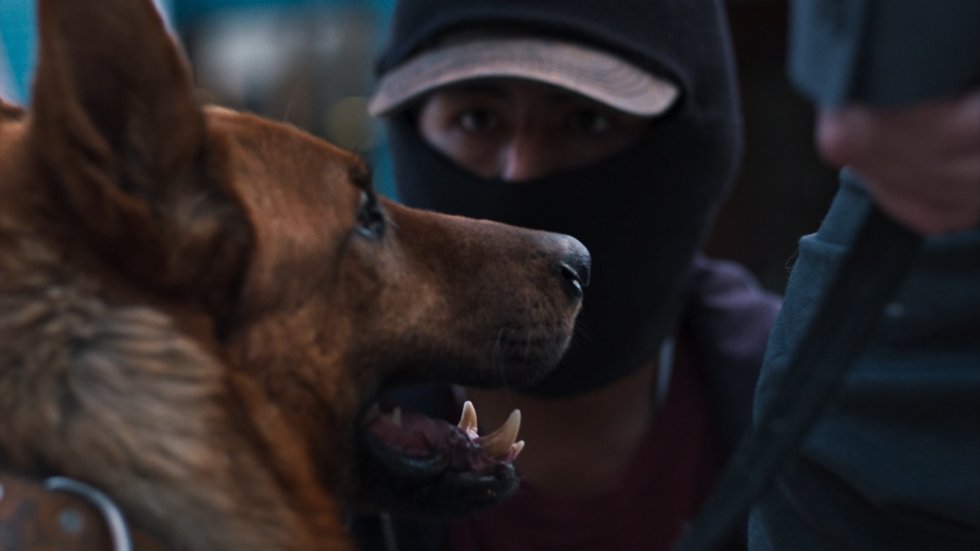
Based in La Paz, Bolivia, “The Dog Thief” is about a young teenager named Martin who shines shoes on the city streets. His mom’s best friend lets him stay in a room in her big old house, but he’s still an orphan with few friends and no other means of supporting himself. That is until his favorite client, Mr. Novoa, a lonely tailor whose only friend is Astor a beautiful German Shepherd he treats like his own son gives the boy hope. At first motivated by the possibility of a reward, Martin steals Astor from Mr. Novoa. But as they spend more time together, something happens between them that neither one expects.
Within the vast landscape of cinema, it often feels like South American movies get lost somewhere within our current film culture. Yes, there have been some very successful contemporary Latin American filmmakers (usually Mexican) such as Alfonso Cuaron or Alejandro Gonzalez Inarritu etc., but nothing has really struck mainstream interest so much so to where these stories should already be known; especially when you look at how Asian cinema exploded over this past decade alone it can sometimes feel few and far between having to search out for those rare gems that deserve more platforms than what they’re currently given. Which makes discovering Vinko Tomičić Salinas’ solo directorial debut feature “The Dog Thief” all the more enjoyable; not only does it show that he is capable on his own but also an emerging voice we should keep our eyes on as well.
“The Dog Thief” follows Martín (Franklin Aro), a young orphan just trying to make it through each day on the streets of La Paz, Bolivia. He’s having trouble at school both academically and socially while secretly living with his dead mother’s friend all while shining shoes just to scrape enough money together for one hot meal… Slowly but surely Martín becomes increasingly obsessed with the idea that Mr. Novoa (Alfredo Castro) may be his father.
Things go downhill after Martín takes part in stealing Mr. Novoa’s dog as a way of making some quick cash realizing along the way that this act could cost him much more than what he initially bargained for when he begins to bond with the older man who is completely unaware of their connection. As a filmmaker, Salinas taps into a more naturalistic style akin to Italian neorealism or even some films birthed out of Third Cinema in the 70s: there is an inherent patience within “The Dog Thief” that I really appreciate; we spend long stretches just watching Martín live his life day-to-day fixated on the simplest things. In many ways Aro’s performance reminds me so much of Sandro Panseri’s work from “Il Posto“; due to its lack thereof it can sometimes come off as stilted but still works for both Martín as a character and overall film. The use mostly non-professional actors throughout “The Dog Thief” gives it a special kind of novelty and authenticity too – you can tell these directors wanted to blend performer with performance which resulted in something incredibly lived-in feeling. The rest of the supporting cast are all very good also, particularly Castro who not only brings experience but also plays well opposite Aro.
The Dog Thief is a story that has stayed with me after reading it because of the complicated relationship between Martín and Mr. Novoa. We see how this bond built on lies affects our main character’s conscience. It’s also interesting to note that these two people who share some emotions are completely dissimilar; one suffers from poverty while having what seems like an insatiable need for parental care, whereas another one is at the end stage of his solitary life and just wants to fill up emptiness (in this case, Martin becomes a substitute for his lost pet). The fact that Martin can often mix up different factors due to their producing similar feelings is touching even if the outcome tends to be too foreseeable.
From the technical side, Salinas’ direction in “The Dog Thief” is very good. He shows lots of different feelings in it using Sergio Armstrong’s captivating cinematography. Salinas uses Armstrong’s work quite well by showing us characters’ changing looks as they get more and more frustrated or abandoned. Also, La Paz city has been shot with a bit tough but still sentimental realism every corner taken on cobblestones roads or every meeting had at hundreds years old buildings looks beautiful here; Salinas really makes you feel like this place lives its own life which leads me to think that there could be no other highlight of “The Dog Thief” than its cinematography. The music score composed by Wissam Hojeij from France also deserves mention because it blended jazz-based motifs alongside Bolivian music; I found Ursula Barba Hopfner’s editing pretty sharp too – it helps maintain good pace throughout those fast 90 minutes.
However much we can appreciate general premise and characters interaction within “The Dog Thief”, it still stumbles too frequently into what we have seen too many times before. Every storyline featured in screenplay written by Salinas himself doesn’t drag audience or any part of itself beyond necessary point; it ends just where it should. This is not typical for debutants who often get lost in their own works. I’m grateful for the cyclical nature of the story and what Salinas wants to say with it, but I feel like he didn’t give as much materialization as needed. For somebody, this could be a bit disappointing after such an interesting beginning like in “The Dog Thief”. These little faults do not affect neither quality nor impact of Salinas’ creation called “The Dog Thief”; maybe this film will stay in shade created by others that served him as models, but still it’s a good start from a new director – let’s remember his name!
For More Movies Visit Putlocker.